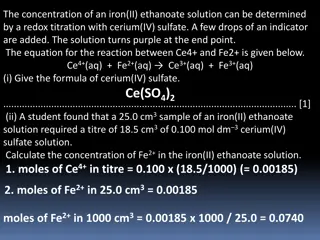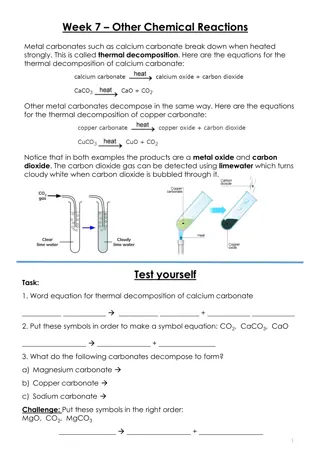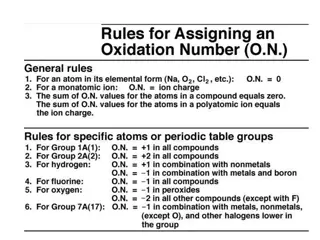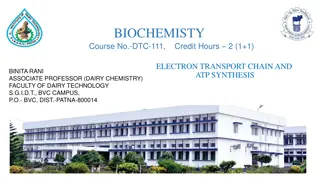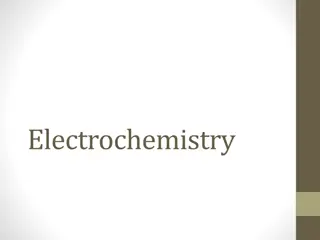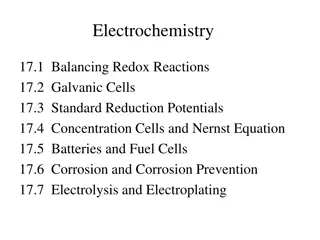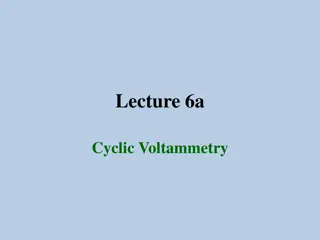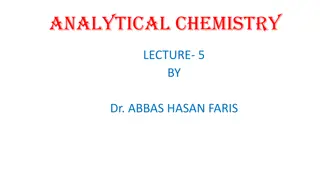Understanding Soil Chemistry and Redox Reactions in Environmental Chemistry
Soil chemistry plays a crucial role in sustaining healthy soils by influencing nutrient availability through oxidation and reduction processes. Redox reactions in soil are impacted by factors like oxygen content and water presence, affecting nutrient supplies. The redox status of soil reflects its nature and plays a key role in various environmental processes. Pourbaix diagrams and redox status measurements provide insights into soil composition and behavior. Overall, a deeper understanding of soil chemistry is essential for environmental scientists and researchers.
Download Presentation

Please find below an Image/Link to download the presentation.
The content on the website is provided AS IS for your information and personal use only. It may not be sold, licensed, or shared on other websites without obtaining consent from the author. Download presentation by click this link. If you encounter any issues during the download, it is possible that the publisher has removed the file from their server.
E N D
Presentation Transcript
Environmental Chemistry soil-composition-soil chemistry Rani Abraham
Syllabus portions The chemistry of processes in Lithosphere; Redox status in soil. pE pH predominance diagrams for redox sensitive elements. Acidity in soil materials. Acid neutralization capacity and the quantification of the soil acidity. Ion speciation in soil solution. Cation exchange capacity and exchange phase composition.
Soil chemistry Healthy soils rely on water, oxygen, air and a balanced supply of nutrients. Chemical reactions within the soil can alter the physical structure of available nutrients. Oxidation and reduction processes involve the oxygen exchanges that take place between water and inorganic materials. These changes affect available nutrient supplies.
Redox reactions The chemical reactions that take place in the soil depend on the physical makeup of each material. The presence of oxygen and water in the soil can increase the likelihood of a redox reaction, depending on the physical makeup of the soil s materials.
REDOX STATUS OF SOIL Indicates the nature of the soil For eg., in wetlands it differentiates between a well drained soil, poor drained soil and submerged soil A waterlogged or anaerobic soil is usually greyish or green in colour, has a low redox potential and contains the reduced form of various soil minerals (Ponnamperuma 1972). An anaerobic environment affects the oxidation and reduction reactions in soil that govern the formation of many species
Redox status in soil standard method measuring the voltage difference between a Pt sensing electrode and a reference electrode (e.g., calomel or Ag/AgCl) inserted directly into the soil (Mueller et al., 1985). The voltage difference between the Pt and reference electrodes is then corrected for the reference electrode s standard voltage relative to the standard hydrogen electrode (SHE, E = 0.0 V), and is recorded as the Eh.
Pourbaix Pourbaix diagram ( diagram (Electrode potential Electrode potential / pH diagram) diagram) / pH Graphical presentation of the thermodynamic equilibrium states of a metal-electrolyte system. Axes Electrode potential of the metal vs. PH of the electrolyte. Oxidizing conditions are described by the top part of the diagram (high positive electrode potential). Reducing conditions are described by the bottom part of the diagram (high negative electrode potential). Acidic solutions are presented in the left side of the diagram (pH lower than 6). Alkaline solutions are presented in the right side of the diagram (pH higher than 6).
Basis of different zones on the plot-Nernst equation The lines of the diagrams dividing different zones of the equilibrium states are calculated by the Nernst equation: E = E0- (0.059/n)*lnCion Where: E0- Standard electrode potential, V; n - number of electrons transferred; Cion- molar activity (concentration) of ions.
Significance of Pourbaix diagrams Allows one to determine the corrosion behaviour of a metal in water solutions i.e. the direction of electro-chemical processes and the equilibrium state of the metal at a certain electrode potential in a water solution at a certain value of PH. Normally the Poubaix diagrams are built for the water solutions with the concentrations of metal ions 10-6M and at the temperature 298K (77 F/25 C).
Pourbaix diagram - illustration An example of a Pourbaix diagram for the system iron-water is presented in the following picture.
The Earths crust Ca Al Fe K Si Mg Na Others O Soil Analysis Ch5 15
Soil Components The 4 parts of soil Soil Air 25% About of the soil volume is solid particles About of the soil volume is pore space Mineral Matter 45% Soil Water 25% Organic Matter 5%
Soil chemistry Soil chemistry Study of the chemical characteristics of soil. Soil chemistry is affected by: mineral composition, organic matter and environmental factors.
Figure : Most soils contain four basic components: mineral particles, water, air, and organic matter. Organic matter can be further sub-divided into humus, roots, and living organisms. The values given below are for an average soil.
Soil Texture Soil Texture- - Texture of a soil refers to the size distribution of the mineral particles found in a representative sample of soil. Particles are normally grouped into three main classes: sand, silt, clay.
Table Table describes the classification of soil particles according to size Type of Mineral Particle Sand Silt Size Range 2.0 - 0.06 millimeters 0.06 - 0.002 millimeters less than 0.002 millimeters Clay
CLAY Probably the most important type of mineral particle found in a soil Characterized by small size and very large surface area of the particles. Highly reactive due to large surface area Has the ability to attract and hold positively charged nutrient ions which are available to plant roots for nutrition. Clay particles are also somewhat flexible and plastic because of their lattice-like design. This feature allows clay particles to absorb water and other substances into their structure.
Soil chemistry-why is it important The chemistry determines what will grow and how well it will grow. One of the most important chemical properties of a soil is its acidity or alkalinity, often stated as the pH of the soil. Factors affecting soil chemistry Factors that affect soil formation. Soils form from the interplay of five main factors namely Parent material, Time, Climate, Relief and Organisms. Parent material: This refers to the mineral material or organic material from which the soil is formed.
Composition of soil Soil is composed of a matrix of minerals, organic matter, air, and water.
OXIDATION AND REDUCTION REACTIONS Soils that alternate between wet and dry go from having a lot of oxygen to not a lot of oxygen. The presence or absence of oxygen determines how soils chemically react. Oxidation is the loss of electrons, and reduction is the gaining of electrons at the soil surface. These type of reactions occur every day, and are responsible for creating things like rust. Soils, because they contain a lot of iron, can also rust, or if they contain a lot of water, can turn a light gray color. This is partially responsible for all of the different colors that are found, and creates the speckles usually found deeper in the soil.
Ion exchange involves the movement of cations (positively charged elements like calcium, magnesium, and sodium) and anions (negatively charged elements like chloride, and compounds like nitrate) through the soils Cation exchange is the interchanging between a cation in the solution of water around the soil particle, and another cation that is stuck to the clay surface. The number of cations in the soil water solution is much smaller than the number that is attached to soil particles.
A. Cation Exchange Capacity Cation exchange capacity (CEC) is the total amount of cations that a soil can retain The higher the soil CEC the greater ability it has to store plant nutrients Soil CEC increases as 1. The amount of clay increases 2. The amount of organic matter increases 3. The soil pH increases
C Cation ation exchange capacity (CEC) exchange capacity (CEC) The total amount of positive charges that the soil can absorb is called the cation exchange capacity (CEC). CEC impacts how quickly nutrients move through the profile. A soil with a low CEC is much less fertile because it cannot hold on to many nutrients, and they usually contain less clays. If your soil has a low CEC, it is important to apply fertilizer small doses so it does not infiltrate into the groundwater. A soil with a low CEC is less able to hold spilt chemicals.
b. Clay has a negative charge. Clay particles are stacked in layers like sheets of paper. Each clay sheet is slightly separated from those on either side. Each sheet has negative charges on it. Negative charges have to be balanced by positive charges called cations. 1/20,000 in
Cation Retention on Soil Clays Calcium, +2 Magnesium, +2 Potassium, +1 Ammonium, +1 Sodium, +1 Copper, +2 Aluminum, +3 Hydrogen, +1
2/3. Organic Matter and pH Hydrogen Nutrients Increasing pH increases cation exchange capacity of organic matter Neutral pH, 7 ( sweet soil) Low pH, 4 - 5 (acidic soil)
B. Negatively Charged Nutrients (Anions) Some very important plant nutrients are anions. 1 2 2 1 Nitrate Phosphate Sulfate Chloride Soils are able to retain some of these nutrient anions. Retention of nutrient anions varies from one anion to another
Phosphate retention in soil 3. Adsorption on oxide surfaces Phosphate anions - Each held by two chemical bonds to the iron oxide surface Iron oxide surface
Nitrate (NO3-) retention in soils Unlike phosphate, nitrate is very weakly held by soils Nitrate does not react to form new solids Nitrate is not held by oxide surfaces NO3- If nitrate is not taken up by plants it is very likely to be lost from the soil
H. Moving nutrients from soil to plants Nutrients in soil solution Plant Root Nutrients on soil clay and organic matter
Excessive Nutrient Loading Nutrients in soil solution X Plant Root Nutrients on soil clay and organic matter Nutrient loss in drainage water
SOIL PH The soil pH is a measure of soil acidity or alkalinity. pH can range from 1 to 14, with values 0-7 being acidic, and 7-14 being alkaline. Soils usually range from 4 to 10. The pH is one of the most important properties involved in plant growth, as well as understanding how rapidly reactions occur in the soil. .For example, the element iron becomes less available to plants a higher the pH is. This creates iron deficiency problems. Crops usually prefer values between 5.5-8, but the value depends on the crop. The pH of soil comes from the parent material during soil formation, but humans can add things to soils to change them to better suit plant growth. Soil pH also affects organisms.
SOIL pH A measure of the degree to which the soil is Acidic or Basic; also known as . . . Soil Reaction
SOIL pH Most agricultural soils pH range from 4 to 9 . . . common productive agriculture soils fall between pH 5 to 8
SOIL pH 2 factors affecting pH are: 1) Amount of precipitation 2) Type of vegetation
SOIL pH AMOUNT OF PRECIPITATION HUMID AREAS (heavy rainfall) ACID SOILS Ca+, Mg+, and Na+ are leached downward and H+ ions replaced by
SOIL pH TYPE OF VEGETATION Vegetation affects pH over period of years: grasslands higher pH forests lower pH
SOIL pH The most critical effects of soil pH are indirect . . . the availability (unavailability) of certain nutrients is greatly influenced by soil pH
SOIL pH Nutrients UNAVAILABLE at higher pH: Cu Copper Fe Iron Mn Manganese Zn Zinc
SOIL pH additionally . . . nitrogen-fixing bacteria associated with legumes are seriously hindered in acid soils Critical with beans and peas Critical with beans and peas
SOIL pH ADJUSTING SOIL pH - Crops vary considerably regarding soil pH preferences
Cation exchange capacity (CEC) the moles of exchangeable positive charge per unit mass 100 g of dry soil usually mmole/100g or cmole/kg (the same value) Ca & Mg contribute twice as much to the CEC as an equivalent number of sodium and potassium ions because of their 2+ charges Soil Analysis Ch5 50




